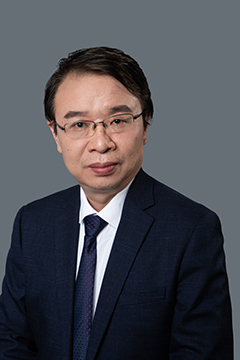
Professor
Department of Pathophysiology, West China School of Basic Medical & Forensic Medicine, Sichuan University
Address: Department of Pathophysiology, West China School of Basic Medical Sciences & Forensic Medicine, Sichuan University, No.17 Section 3, Renmin South Road, Chengdu, Sichuan, P.R.China.
Phone Number: +86-13880089687
Email Address: huangpanxiao@sina.com
Professor Huang Ning, Doctor of Medicine, Supervisor of Doctoral Students. Council Member of Chinese society of pathophysiology, Vice chairman of Specialized Committee of Inflammation, Fever, Infection, and Low temperature of Chinese society of pathophysiology, Director of Sichuan Physiological Science Society. Sichuan Provincial Academic and Technical leaders, Experts in Sichuan province with outstanding contributions, Sichuan provincial health department academic and technical leader, Head of Excellent Pathophysiology Course in Sichuan Province. One of the academic leaders of basic science research and teaching talent training base (Basic Medicine) and one of the 211 key disciplines in Sichuan University. Director of Department of pathophysiology. He was the vice Dean of West China College of Basic and Forensic Medicine, Sichuan University, and was the head of CMB cell molecular pathophysiology discipline. The Major Member of the "985" drug innovation platform of Sichuan University. He has won more than
10 fundings from National Natural Science Foundation and the CMB international cooperation Funding. He was a the editor for 7 books and published more than 100 research papers, He won the second awards of Science and Technology Progress of Sichuan Province, and one national patent. He is editorial board member of Journal of Sichuan University (Medical Edition), Chinese Journal of pathophysiology and Chinese Journal of antibiotics.
Education and Training:
Professor Ning Huang graduated from the department of clinical medicine at West China Medical University in 1985, and started working as a teacher in the university. He then received his Master’s and Doctoral degrees. He wassuccessivelypromoted to be a lecturer, associate professor, and professor.
Area of Interest:
Innate Immunity and Signalings of Inflammatory gene regulation; Identification of Drug targets and Drug Design; Epigenetic regulation mechanism of Innate Immunity; Innate immunity and Human Major Diseases.
Selected Publications:
1.Liu K, Wang X, Sha K, et al. Nuclear protein HMGN2 attenuates pyocyanin-induced xidative stress via Nrf2 signaling and inhibits Pseudomonas aeruginosa internalization in A549 cells.Free Radic Bio Med. 2017; 108:404-417.
2. Xu Q, Liu X, Wang X, et al. Growth arrest-specific protein 7 regulates the murine M1 alveolar macrophage polarization.Immunol Res. 2017; 65(5):1065-1073.
3. Li H, Shen X, Zhou X, et al. Antibacterial mechanism of high-mobility group nucleosomal-binding domain 2 on the Gram-negative bacteria Escherichia coli.J Zhejiang Univ Sci B. 2017; 18(5):410-420.
4. Teng Y, Miao J, Shen X,et al. The modulation of MiR-155 and MiR-23a manipulates Klebsiella pneumoniae Adhesion on Human pulmonary Epithelial cells via Integrin α5β1 Signaling.Sci Rep. 2016; 6:31918.
5. Shen X, Teng Y, Sha K, et al. Dietary flavonoid luteolin attenuates uropathogenic Escherichia. Coli invasion of the urinary bladder.Biofactors. 2016; 42(6):674-685.
6. Yang X, Sha K, Xu G, et al. Subinhibitory Concentrations of Allicin Decrease UropathogenicEscherichia coli(UPEC) Biofilm Formation, Adhesion Ability, andSwimming Motility.Int J Mol Sci.2016; 17(7):979.
7. Wang X, Li J, Chen S, et al. Knockdown of HMGN2 increases the internalization of Klebsiella pneumoniaeby respiratory epithelial cells through the regulation of α5β1 integrin expression:[J].Int J Mol Med. 2016; 38(3):737-746.
8. Xiong F, Liu K, Zhang F, et al. MiR-204 inhibits the proliferation and invasion of renal cell carcinoma by inhibiting RAB22A expression.Oncol Rep. 2016; 35(5):3000-3008.
9. Xu G, Shi H, Ren L, et al. Enhancing the anti-colon cancer activity of quercetin by self-assembled micelles.Int J Nanomedicine. 2015; 10:2051-2063.
10. Zheng S, Ren L, Li H, et al. High-mobility group nucleosome-binding domain 2 protein inhibits the invasion of Klebsiella pneumoniae into mouse lungs in vivo.Mol Med Rep. 2015; 12(1):1279-85.
11. Shen X, Ren L, Teng Y, et al. Luteolin decreases the attachment, invasion and cytotoxicity of UPEC in bladder epithelial cells and inhibits UPEC biofilm formation.Food Chem Toxicol. 2014; 72:204-11.
12. Xiang G, Deng X, Wei X, et al. Novel thermosensitive hydrogel for preventing formation of abdominal adhesions.Int J Nanomedicine. 2013; 8:2453-63.
13. Yang X, Huang N. Berberine induces selective apoptosis through the AMPK‑mediated mitochondrial/caspase pathway in hepatocellular carcinoma .Mol Med Rep. 2013; 8(2):505-10.
14. Zheng F J, Shi L, Yang J, et al. Effect of tea polyphenols on the adhesion of highly metastatic human lung carcinoma cell lines to endothelial cells in vitro.[J].Asian Pac J Cancer Prev. 2012; 13(8):3751-5.
15. Deng LX, Wu GX, Cao Y, et al. The chromosomal protein HMGN2 mediates lipopolysaccharide-induced expression of β-defensins in A549 cells. FEBS J. 2011; 278(12):2152-66.
16. Cao Y, Wu G, Fan B, et al. High mobility group nucleosomal binding domain 2 protein protects bladder epithelial cells from Klebsiella pneumoniae invasion.Biol Pharm Bull. 2011; 34(7):1065-71.
17. Deng L, Pan X Y, Wang L, et al. Hemoglobin and its derived peptides may play a role in the antibacterial mechanism of the vagina. Hum Reprod. 2009; 24(1):211-8.
18. Li M, Pan X, Li Y, et al. Purification of antimicrobial factors from human cervical mucus. Hum Reprod. 2007; 22(7):1810-5.